
Through science to life
When you come to the Crimea don't miss the opportunity of visiting its southern coast and, naturally, the town of Yalta, usually called the pearl of the Crimea. Here you will absorb unforgettable impressions: the caressing boundless sea, the richly flooding sunshine, mountain views set in a romantic haze, and all around you - the lush greenery of parks and gardens, this wonderful kingdom of Crimean nature. But to obtain a deeper insight into Crimean flora you must go to the Nikitsky Botanical Garden. Situated only six kilometres east of Yalta, it is an incomparable corner in the Crimea which has long been known as the green treasury of the Soviet Union.
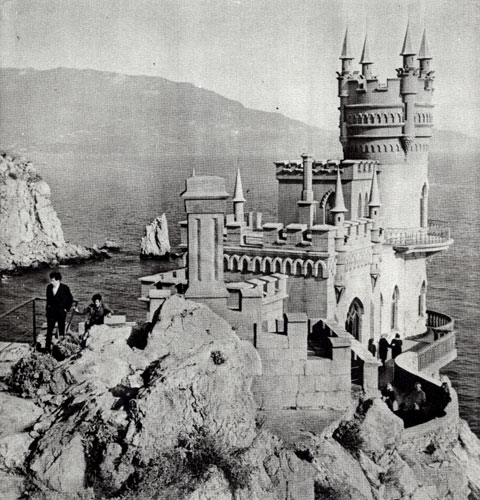
The boundless sea
The story of its foundation is linked with the cultivation of the Crimean lands after the Crimea was joined to Russia in 1783.
Attracted by such favourable natural conditions, the Russian aristocracy came here to build palaces and summer residences, surrounding them with parks and gardens. It was impossible, however, for the gardens to play any role in the development of local horticulture and viticulture as they were privately owned and frequently changed hands. The Nikitsky Botanical Garden was called upon to fill the gap.
It was founded in the September of 1812 as the Imperial botanical garden. For this purpose the site was chosen near Nikita, a village founded by Greek settlers four centuries before. Ch. Stevens, the most knowledgeable botanist in Russia and an expert in horticulture, was appointed Director of the Garden. However, the organizing of the botanical garden was not an easy task to solve: the money allocated for the undertaking was insufficient and, in addition, there was a shortage of workers and a complete lack of experienced gardeners. Despite these difficulties, Ch. Stevens set himself the lofty aim of founding a real scientific establishment for promoting the development of horticulture in southern Russia. The programme of the garden's activities envisaged three main lines: to assemble a comprehensive collection of sun-loving plants, to set out plantations of southern fruit cultures to help Crimean gardeners, and to start a nursery which would grow plants for sale.
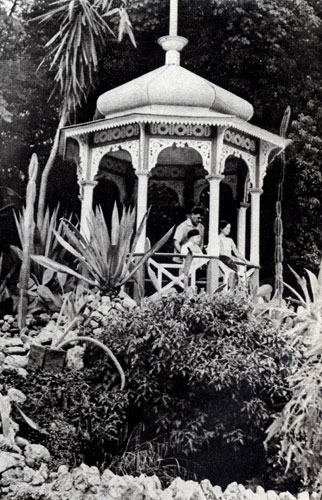
The emerald green of the parks
Stevens' inexhaustible energy and selfless devotion to science helped him carry out this complex programme. He made business contacts with many famous institutions and private persons both in Russia and abroad and received from them seeds and saplings. The result was that three years later the Nikitsky Garden's nursery had sufficient stock to sell some 150 species of fruit, ornamental and other plants.
Ch. Stevens paid much attention to the study and collecting of native species of fruit trees. During the twelve years that the Garden was under his management, he made a rich collection of decorative plants, established a valuable herbarium, founded the scientific library .and museum, and set up a horticultural school.
In 1824 his post was taken over by the talented agriculturist and skilled organizer N. Gartvis who was Director of the Garden for forty years. Under Gartvis, viticulture, decorative gardening, fruit, tobacco, and vegetable growing, as well as the introduction of cultivated plants were dealt with on a large scale.
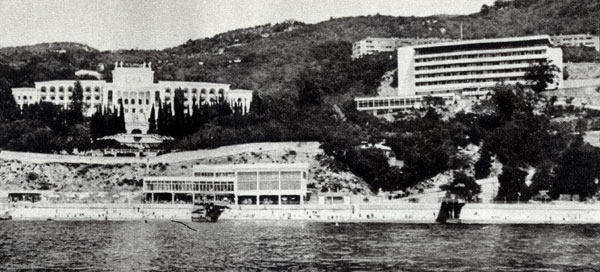
The snow-white buildings of sanatoriums and holiday homes
Estimating the role of both directors in the activities of the Nikitsky Botanical Garden, Academician N. Vavilov, an outstanding Soviet scientist, pointed out, "The names of ... Ch. Stevens and N. Gartvis are linked with the remarkable times of the well-considered introduction of valuable species of fruit cultures, vines and ornamental plants which greatly influenced not only the southern coast of the Crimea, but also other regions in the European part of our country."
The celebration of its centennial was an important event in the life of the Nikitsky Botanical Garden. Timed to coincide with this date a Maritime Park was laid out. Many subtropical plants, previously cultivated only in greenhouses, were introduced in the park.
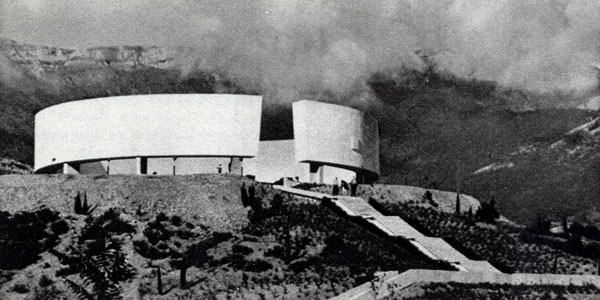
Architectural monuments
The prerevolution period in the development of the Nikitsky Garden was somewhat complex: the flourish of botany as a science, which lasted a number of years and was connected with the activities of such outstanding Russian botanists as V. Lyubimenko, N. Kuznetsov and E. Wulf, repeatedly went into periods of decline. It was only after the Great October Socialist Revolution that the Nikitsky Botanical Garden became a large scientific-research establishment capable of solving the most complex scientific problems which were of great economic importance for the Soviet Union.
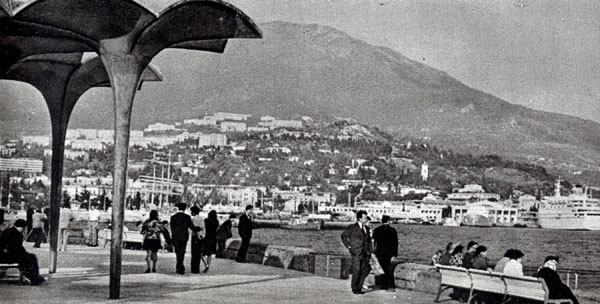
Historical monuments
During the first few years following the Civil War, systematic scientific work gradually got under way, the collection of subtropical plants was considerably enlarged and new laboratories set up. Soon, several individual establishments branched off from the Nikitsky Garden, including the famous scientific-research institute of wine-making and viticulture, "Magarach." In 1934, the Nikitsky Botanical Garden was included in the USSR Academy of Agricultural Sciences named after Lenin.
During the temporary occupation by the German-fascist invaders, the Nikitsky Garden suffered heavy losses: many plants were destroyed or injured, valuable scientific equipment and the herbarium of 60,000 sheets were removed from the country.
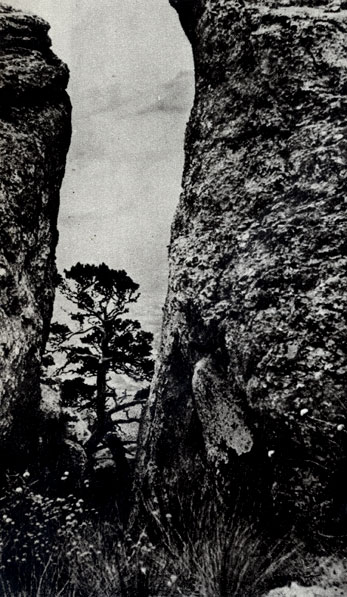
The southern coast of the Crimea
Immediately following the liberation of Yalta in 1944, the Garden director, A. Koverga, set out in search of the herbarium. After covering thousands of miles through Poland and Germany, he finally discovered the herbarium in a small town near Berlin and brought it back to the Crimea.
After the war, thanks to the concern shown the Garden by the Communist Party and the Soviet Government, the scientific staff was again able to carry out extensive research work linked with agricultural production. In September 1962, for fruitful work over a period of many years and for great services in the field of horticulture for the southern regions of the Soviet Union as well as in honour of its 150th anniversary, the Nikitsky Botanical Garden was awarded the Order of the Red Banner of Labour. On this occasion a memorial medallion was cast bearing the following inscription, "The power of science lies in its links with practice, with life." And ever since this has become the Garden's motto in its many-sided activities.
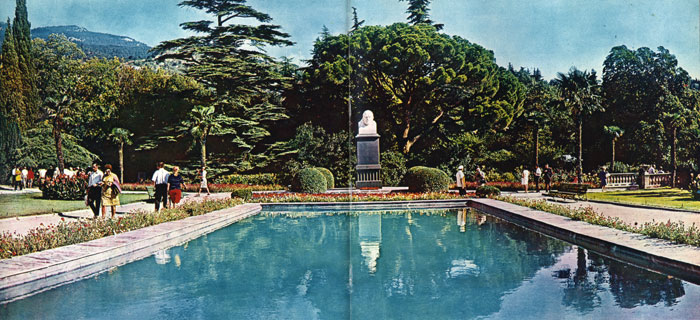
Square in the Nikitsky Botanical Garden
Today, the Nikitsky Botanical Garden is a well-known scientific-research establishment which maintains scientific and commercial contacts with various organizations in more than 50 countries. Of the 1,000 specialists employed in the Garden, 120 are scientific workers, including 6 Doctors and 87 Kandidats of Science. The great Nikitsky Garden, with its three experimental-production centres, covers an area of some 1,000 hectares. The Garden's central branch includes 11 departments and laboratories. Here the scientific staff is the most numerous. Trials of ornamental plants, including their vegetative reproduction and growth from seed, are carried out in the Maritime branch (settlement of Frunzenskoye, Alushta District). The Steppe branch (settlement of Gvardeiskoye, Simferopol Region) specializes in the selection of southern fruit plants (peach, apricot and cherry), of nut trees (almond and walnut), and of new kinds of volatile oil bearing and ornamental plants, to be introduced into other regions of the Soviet Union.
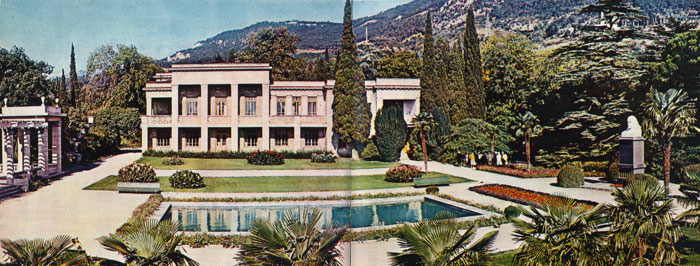
The main office building, housing the directorate of the Nikitsky Garden, a scientific library and conference hall
The scientists of all these branches investigate the possibilities of using plant resources of foreign as well as native florae for the national economy of the USSR's southern zone. At the same time due attention is paid to problems of preserving ecological balance of nature and to improving the cultivated landscape in the Crimea.
Over the last few years more than 100 varieties of peaches, apricots, cherries, myrobalans, plums, almonds, figs, pomegranates and walnuts, as well as a number of ornamental plants have been grown by the scientists of the Nikitsky Garden and distributed to various regions for mass introduction. According to official data nearly 50 per cent of all fruit trees cultivated in the southern districts of the Soviet Union originate from the Nikitsky Botanical Garden. Also in recent years more than 2,000 hectares of land in the Crimea have been given over to commercial plantations of sweet almond varieties originating in Nikitsky.
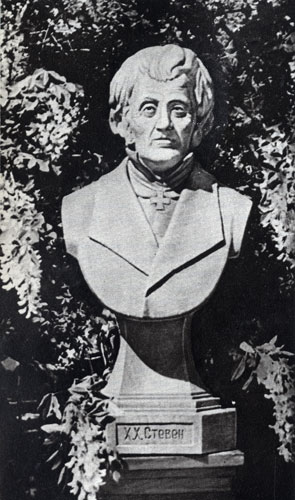
Sculptural portrait of Ch. Stevens (1781 — 1863), first Director of the Nikitsky Botanical Garden
A considerable area of the country's aromatic plantations of roses, lavender, irises, violets come from cultivars raised in the Nikitsky Garden during the years of Soviet power.
For many years now the Nikitsky Botanical Garden has taken part in the Exhibition of Economic Achievements of the USSR. Its exhibits have repeatedly won awards of EEA first-class diplomas and certificates and its scientific workers medals for their achievements in scientific-research work and for introducing these attainments into wide commercial production. Today, the Nikitsky Garden's plant collections number more than 28,000 species, varieties and hybrids. Numerous visitors to the Garden show special interest in the great variety of subtropical trees. The Nikitsky arboretum, where more than 1,500 species of ornamental trees and shrubs are collected, covers an area of over 40 hectares and consists of four separate parks: the Upper Park, the Lower, the Maritime Park and the park on Cape Montedor.

Diploma from the 1893 International Exhibition in Chicago verifying that the Nikitsky Botanical Garden was awarded a medal for its excellent muscat wine
Unlike other arboretums in our country where the laying out follows the botanical principle, the Nikitsky arboretum features decorative planning. The incomparable collections of exotic plants are arranged according to a single artistic design which presents a superb example of park landscaping. So, it is only natural that the Nikitsky Botanical Garden has long been looked upon as one of the most beautiful in the world.
A tour of the Nikitsky Garden begins with the Upper Park. It was laid out in typical landscape style during the last century. Here you can see rare species of conifers, ever-green shrubs, a splendid rosarium, a rock garden and displays of chrysanthemums and new varieties of the clematis.
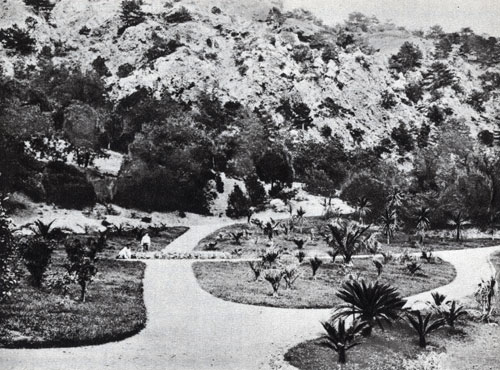
The Maritime Park. 1920 s. Archives photo
Past the entrance to the Upper Park, in front of the main office building, there is a parterre. Housed in the office building are the Garden's directorate, a conference hall and scientific library. The austere classic forms of the building's facade and the airy colonnade of the Summer theatre harmonize with the rectangular lawns of the parterre with a pond in the centre. A group of ornamental trees and shrubs enlivened by brilliant patches of flowers surround the pedestal of the Lenin sculptural portrait.
Chinese fan palms grow on the lawns of the parterre, a group of slender pyramidal cypresses and columnar English yews flank the path leading to the office building. Farther on, are Atlas cedars and stone pines, tree species cultivated in the Nikitsky Garden from the early 19th century.

Medallion issued on the occasion of the Nikitsky Garden's centennial bearing the inscription "Through Science to Life"
Of special interest in the Upper Park is the shady alley of pyramidal cypresses which begins with two towering 90-year-old giant sequoias. Near the ornamental pond there is a majestic redwood, a native of California's maritime region which in its original home reaches a height of 110 metres.
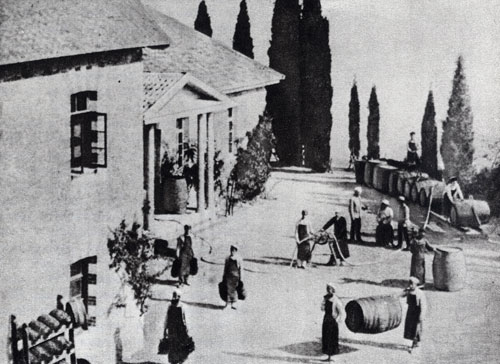
Wine cellars of the Nikitsky Garden 1895, Archives photo
The Nikitsky rosarium is a really marvellous sight to behold. Here you will find various species of roses of native and foreign selection. More than 30 new cultivars, now widely spread in our country's southern regions, have been raised over the post-war period. The mother rose collection numbers more than 2,000 varieties. Every year some 100,000 rose cuttings are shipped from the Nikitsky Garden to various regions of the country.
The rock garden in the Upper Park is particularly beautiful: low drought-resistant perennials which flower the year round and are massed among natural Crimean boulders offer an infinite variety of splashes of colour.
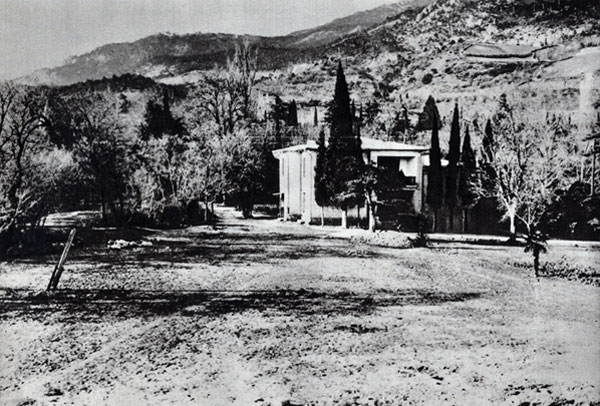
Parterre in the Nikitsky Garden before its redesign in 1935 — 1937
Chrysanthemums are the reigning beauty of the park in autumn. A special display ground features many superb species and varieties from countries abroad. There are also home varieties raised in the Nikitsky Garden, such as "Happy Childhood," "Moonlight Serenade," "Distant Star," "Cosmos," "Charmer," "Black Sea Rose," etc.
Outstanding amidst the infinite wealth of greenery is the weeping glaucous Atlas cedar, a truly natural wonder whose boughs drop to the very ground. It is native to Algeria's mountains and can be grown only through grafting.
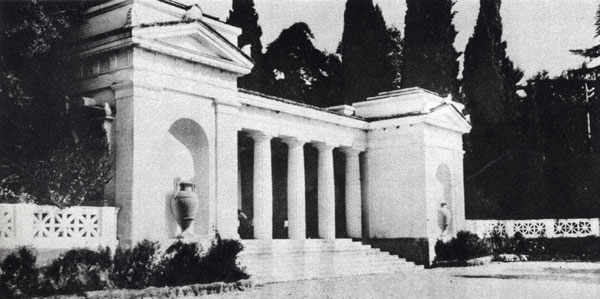
Entrance to the Lower Park. 1930 s. Archives photo
A lookout point with an Aleppo pine terminates the grounds of the Upper Park. Here wide stairs descend to the Lower Park, the oldest section in the Nikitsky Garden. During the first years following its foundation, valuable species of leaf-bearing evergreens, palms and bamboos were imported from abroad. Today, you will find century-old groves of Lebanon cedars with their unusual flat crowns, mighty cork oaks, silvery olives. These groves have become unique monuments of nature and of the people's determination for thanks to the latter the Crimea's stony slopes were turned into a beautiful garden.
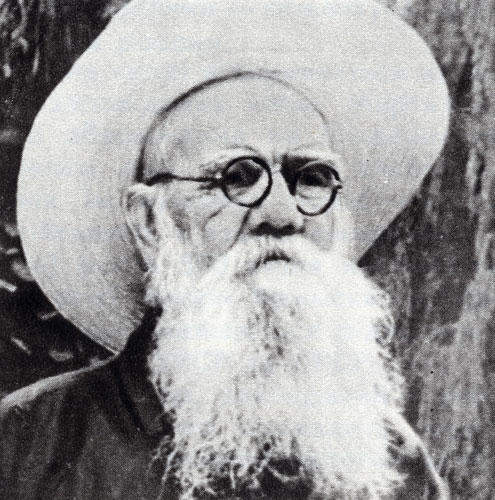
Gardener S. Kozeichuk who worked for the Garden from 1891 to 1952. Archives photo
Sun-loving plants with thick pulpy leaves and stems are put outdoors in summer. They are mostly natives of Mexico: cereuses, agaves, prickly-pears, etc. Next to them, at the end of the palm alley, there is a decorative Japanese banana, noted for its large leaves. Of special interest in the Lower Park are the trees still living today which are descended from plants of the Carboniferous Period, namely the ginkgo, metasequoia, the large-fruited and small-fruited strawberry tree, Montezuma pine and some other rare species.
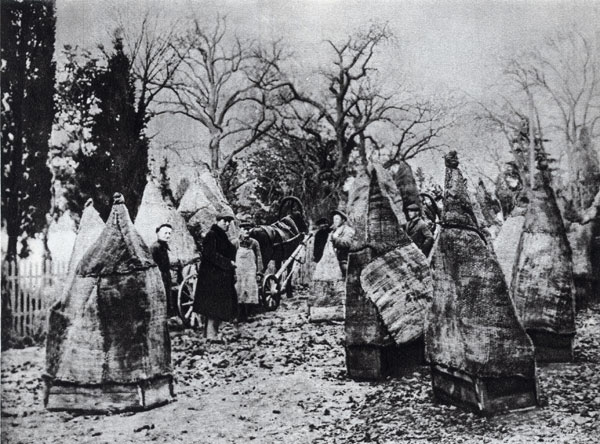
Packing saplings to ship inland
The Maritime Park extends as far as the sea coast and consists of three flat terraces at different levels. It begins with an alley of Chinese fan palms, the most frost-resistant plant on the Crimea's southern coast which can usually withstand the winter cold without protective cover. The alley leads to the palmarium which is laid out around a magnolia with specially large flowers, an evergreen from the subtropical zone of North America. In addition to palms that winter without covering (dwarf palm and sabal), you can see other tropical species taken outdoors from the greenhouse in summer. On your way to the sea you will pass by a bamboo grove, past a myrtle, a sweet olive or osmanthus, a mastic tree and other sun-loving plants.

Working up teasels. Early 1930 s. Archives photo
The embankment along the Maritime Park offers beautiful views of the rocky slopes of the Cape Martian State Reserve on the east. The purpose of its foundation in 1973 was to preserve on the Crimea's southern coast a unique relict forest of the juniper, the small-fruited strawberry tree and their accompanying shrubbery - the Crimean rockrose, jasmine, butcher's broom and some others. Five hundred kinds of seed plants, i. e, one fifth of the Crimean flora, thrive in the reserve's grounds covering only 120 hectares. These seed plants include over thirty rare and disappearing species which are listed in the Red Books of the UkrSSR or the USSR.
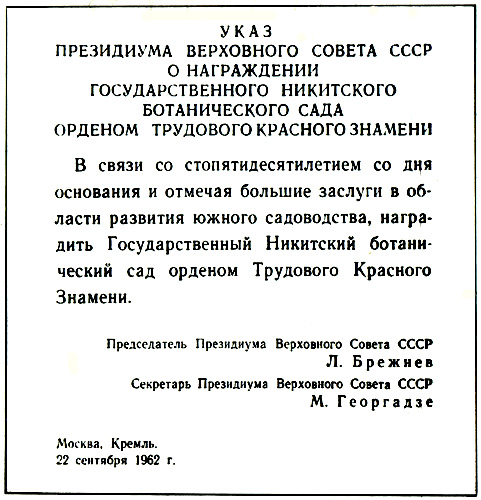
Memorial document issued to commemorate the 150th anniversary of the Nikitsky Botanical Garden
Montedor Park, laid out over the last few years, can be seen on the west. The road to the park runs through plantations of relict conifers: the giant sequoiadendron, evergreen redwood, metasequoia, pinus eldarica, some varieties of Mexican pines, the bald cypress, incense cedar, etc.
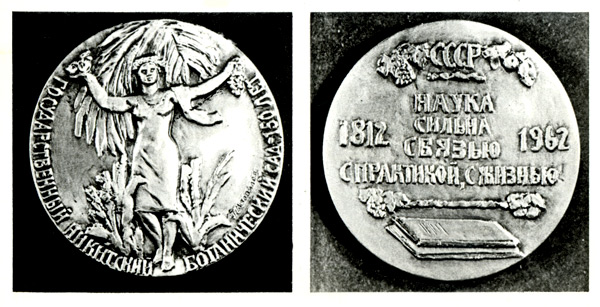
Memorial nedallion issued to commemorate the 150th anniversary of the Nikitsky Botanical Garden
The Nikitsky arboretum wears its green attire all the year round. Even in winter, when the ground is covered with a thin snowy carpet, you can still see flowering shrubs here and there. At all seasons of the year the Nikitsky Botanical Garden is visited by many tourists who are particularly numerous in summer. Visitors to the Garden include Soviet and foreign scientists, students and schoolchildren, excursionists from all over the world. Guides tell them about the Garden's rich plant collections, and how scientists and selectionists preserve and increase this natural wealth for the benefit of the living and the generations to come. Anyone who come to the Garden will carry home with them a feeling of truly aesthetic delight born of direct contact with this wonderful kingdom of greenery, a feeling that will last a lifetime.
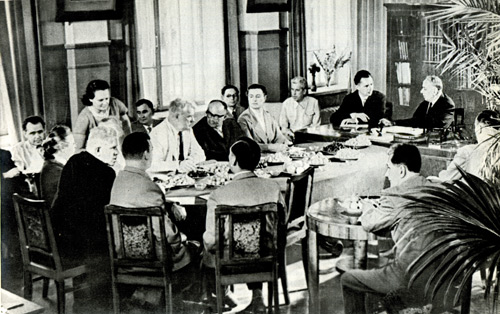
Conference of the Nikitski Garden's Academic Council devoted to the transference of new species of southern fruit plants into state trial
How to prepare adjusting entries: step-by-step guide.
|
ПОИСК:
|
При использовании материалов активная ссылка обязательна:
http://flowerlib.ru/ 'Библиотека по цветоводству'